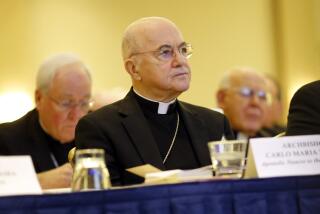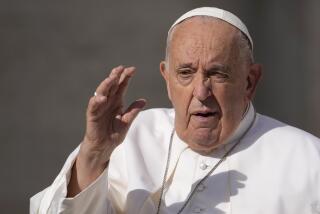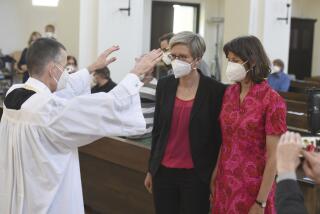O’Connor Renews Issue of Bias Against Catholicism : New York’s cardinal accuses newspapers of ‘bashing’ his religion. Study concludes press depicts church, teachings as ‘oppressive.’
They were only a few lines in an article on a larger subject. But the remarks by Cardinal John J. O’Connor of New York have set off a new storm over an old debate concerning the nation’s 55 million Catholics:
Are the American media biased against Catholicism?
“This Lent, ‘Catholic bashing’ has been the in thing,” O’Connor wrote in Catholic New York, the archdiocesan newspaper. “Columnists and editors who are censored for ethnic slurs or attacks on virtually any other people can romp all over the place at the expense of Catholics who dare to publicly uphold their faith.”
O’Connor’s remarks followed the controversy in New York over whether Irish gay rights activists should have been allowed to march in the St. Patrick’s Day parade. New York Times columnist Anna Quindlen, a Catholic, argued that parade sponsors had confirmed false stereotypes of the Irish as “antediluvian bigots” by initially trying to keep the homosexual group out.
Others went further. New York Post columnist Pete Hamill, himself an Irish Catholic, compared the opponents of the gay marchers to a “Terminal Donkey . . . barely risen from the primeval bogs of Ireland.”
Since then, the issue has been broadened by two Roman Catholic groups that sponsored a major study by the Center for Media and Public Affairs called “Media coverage of the Catholic Church.”
The study concluded that while most coverage of church doings is innocuous, when it came to controversies involving Catholic teaching, the media have depicted the church as an “oppressive and anachronistic” institution that is pitted against “reformers from within and without.”
And in most of these disputes, “the church came out on the losing side of the issue debated.” The report studied coverage in the New York Times, the Washington Post, CBS Evening News and Time magazine over the past 30 years.
For some Catholics, these conclusions “were so obvious they hardly needed demonstration,” said Michael Novak, a religious philosopher at the American Enterprise Institute and himself a Catholic.
With its traditions of faith in authority, “the Catholic Church flies defiantly in the face of the predominant cultural orthodoxies of the United States,” said Father Richard J. Neuhaus, a leading conservative theologian, thus becoming a target of the mainstream press, which reflect the predominant culture.
To scholar Novak, the roots of this suspicion of Catholicism go even deeper.
“We call the Catholic Ages the Dark Ages and the period after it the Enlightenment. The flogging of Catholicism is part of our language, part of the air we breathe.”
George Weigel, a conservative Catholic and author who is the director of the Ethics and Public Policy Center in Washington, argued that “most of the people who run most of the news organizations are thoroughly secularized. So they need categories into which to fit these strange guys with black cassock with red piping. And they reach for these conventional labels: authoritarian, hierarchical.”
But to infer that challenging the church leadership reflects a bias against Catholics or Catholicism in general is wrong, argued New York Times columnist Quindlen.
“I don’t think criticizing the pronouncements of the archbishop is anti-Catholic any more than I do criticizing George Bush to be anti-American,” Quindlen said. “We (Catholics) have a multiplicity of opinions.”
In fact, “the charge . . . that the press views the church as oppressive is probably true, but only because the institutional church is oppressive,” said Father Andrew Greeley, a Catholic priest, sociologist and novelist.
Rather than bearing hostility toward Catholics, historian, author and Catholic Gary Wills argues, the media in general “tread very gingerly in their approach to churches. They don’t want to anger the faithful.”
But both sides agree that much press coverage of Catholics and religion in general is inadequate and plagued by ignorance.
Weigel and Neuhaus are inviting reporters to a meeting next month in New York. One of the issues will be how the press can cover more accurately what is going on inside America’s churches.
Still, the main problem may never disappear. “Dissent is news,” Wills said. “As Lord Chesterton said: Journalism is there to tell us Jones is dead, even though it didn’t tell us he was alive.”
More to Read
Sign up for Essential California
The most important California stories and recommendations in your inbox every morning.
You may occasionally receive promotional content from the Los Angeles Times.










